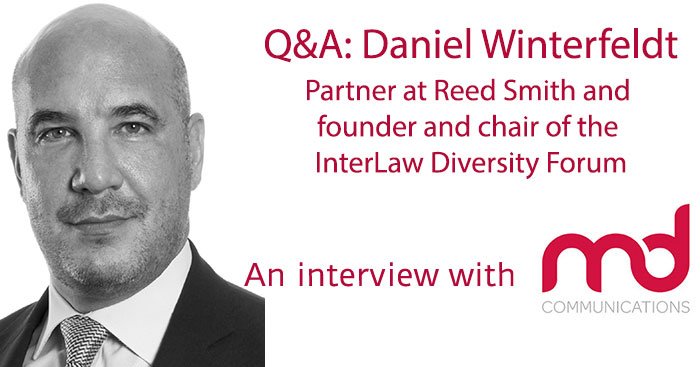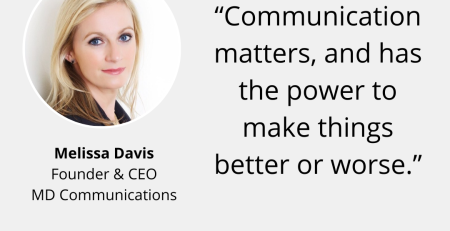Daniel Winterfeldt, the founder of the InterLaw Diversity Forum, talks about work-life balance at an international firm, why he set up the forum, the growing importance of diversity when selecting counsel and why he thinks law firms should set diversity targets.
Daniel, you are the founder and chair of the InterLaw Diversity Forum. What led to you creating this organisation?
So I went to law school in New York and worked on Wall Street at the start of my career. And since my university days, I have been openly gay both in my personal and professional life. But when I came to London in 2000, I noticed there was this big difference in people’s acceptance of diversity compared to the US, especially around LGBT+. It felt off – no one seemed to be “out” – I didn’t know any lawyers that were. The partners I knew of were not “out” at work, so without senior role models I thought you couldn’t be “out” and be a law firm partner in the UK. So I was moved to fix the issue.
The InterLaw Diversity Forum came about in 2008 when I joined Simmons & Simmons as a partner. I had founded a few years before a group that linked US securities lawyers with capital markets market participants, including bankers, settlement systems, the London Stock Exchange, etc. I thought: “why don’t we apply this approach to diversity?”
We started doing monthly meetings and had good attendance from the beginning, including mostly young LGBT+ lawyers who were “out” and proud. We got involved in research projects quickly and co-authored a “barriers” report with the Law Society on LGB solicitors, alongside Law Society reports on gender and race/ethnicity… reading these reports I realised the stories were very similar. I previously thought things might have been different for those from ethnic minorities race but then realised those lawyers were saying the same thing as women had been saying for years: “I don’t feel part of the group” or “I don’t get high quality work”. I was also concerned about LGBT+ progression – there were no visible places for us at senior levels of the profession. I was a junior, salaried partner and one of the most senior LGBT+ lawyers in the UK.
The InterLaw Diversity Forum published the Career Progression Report in the Legal Sector in 2012 which focused on progression, flexible working, seniority, social mobility – all strands of diversity and inclusion plus social mobility. That research really changed how the Forum was run. That research backed up theories around ‘intersectionality’ for the UK legal sector – that the more boxes you ticked for diversity, the less money you earned. We could match the qualitative to the quantitative findings. It wasn’t because certain people just aren’t as good or complaining. The social mobility issue was stark – we saw this huge emphasis on Oxbridge – all the top earners went there, which of course also impacts gender, race/ethnicity, etc. It confirmed that all my impressions on the issue were true and we recommended that legal employers have to push to change culture, engage in leadership training and to adopt diversity targets.
You mentioned that it felt as if no one was “out” in London. Do you have any specific memories or experiences that made you feel you needed to get more involved in making a difference?
Our research reports a lot of banter… a lot of homophobic banter in work that made people uncomfortable, as well as some more disturbing behavior. It has to do with society. There’s a difference between the law and between culture so just because the laws here are more advanced than the US doesn’t mean they’re more progressive.
There’s a lot of work to be done in the UK. If you talk to anyone they’ll have stories about their challenges. It’s not just LGBT people, many in society are uncomfortable around people of a different race or those with a disability. We have a lot of work to do as a society, as well as within our workplaces, to reach “acceptance without exception” as Stonewall would say.
It has long been debated over whether international firms can realistically achieve their business objectives, meet client demands, and at the same time allow staff to have a work/life balance. This would inevitably see an increase in the number of female lawyers retained if they decided to have a family. As a partner at a high-ranking US firm who specialises in capital markets work – which understandably involves long hours and a lot of pressure – do you think it’s possible?
Absolutely! What it requires is a change in culture and management style. I do capital markets and transactions work and have had three senior associates. One works by the hour, another is a flex time worker, who could do 60 hours a week to having no hours and work remotely, and another senior associate who works full time with a special arrangement. Having this system meant I just had to put the pieces of the puzzle together. Yes, it meant more work as a manager for me but one of my lawyers is in New York so when that persons goes home at 6pm, she can pass off her work to us in London and we take over.
We make the most of time zones. People that say you can’t do it lack imagination. If you’re in a large firm and you have all these offices and people – use them! Engage people in different offices. It’s all beneficial with regards to learning and development for talent across the firm. Law firms can work with partners and managers to help them manage in better, more efficient and more inclusive ways.
Do you agree with law firm diversity quotas? There’s been a lot of scepticism over whether firms are just using them as PR tactics and if they’re actually feasible goals.
We recommended targets – not quotas, which are not legal. Unfortunately female partners at senior levels have been hovering at 13% to 15% for about 20 years. If every firm said “we want to move that dial a little further every year”, or if clients decide to put that pressure on them, they would do it.
But every time firms announce their new partnership class, its nearly always salaried or at very low levels of equity – and women stay at the bottom rungs. Firms need to be setting targets for senior levels of the partnership, as well as their boards. Even a modest 1% to 2% movement per year would have a large impact in the next decade.
We have spoken to many GCs who increasingly instruct their external counsel to use diverse teams for tendered work. Is this a trend you have noticed and do you think its an effective way of pushing diversity?
I think it’s just the beginning. Clients have a large role to play in working with their panel law firms to collaborate on change around D&I. Clients will start asking beyond team composition and go into more transparency around credit, promotion, etc. Does it matter if a law firm’s team is diverse if they’re not benefiting individually in their remuneration or advancement from doing that work.
What’s really needed is for firms to analyse the top levels of management at the profession and how they give diverse people credit for the work they do – and making sure their careers are advancing. Let’s see more diverse talent moving up the top. Sometimes I talk to in-house counsel and they say: “I think this firm is really good at diversity” but if you dig down and look at the numbers the picture is not so great.
The InterLaw Diversity Forum’s Apollo Leadership Initiative talks to in-house lawyers about what good looks like. What questions they should be asking to get the right data. We’re not trying to get firms removed from panels we’re talking about being collaborative and having law firms and clients work together.
What’s your view on law firm directories? Do you think they’re a useful tool for clients to scope out diverse talent?
They are good because they spend a long time actually talking to clients. You do get real feedback. As far as diversity goes, they’re starting to do a bit more around the issue; Chambers and Partners is relaunching its diversity programme and has a wide reach and impact.
They’re doing good stuff but neither them or The Legal 500 have integrated diversity into the core legal rankings process – this would be a welcome innovation.












